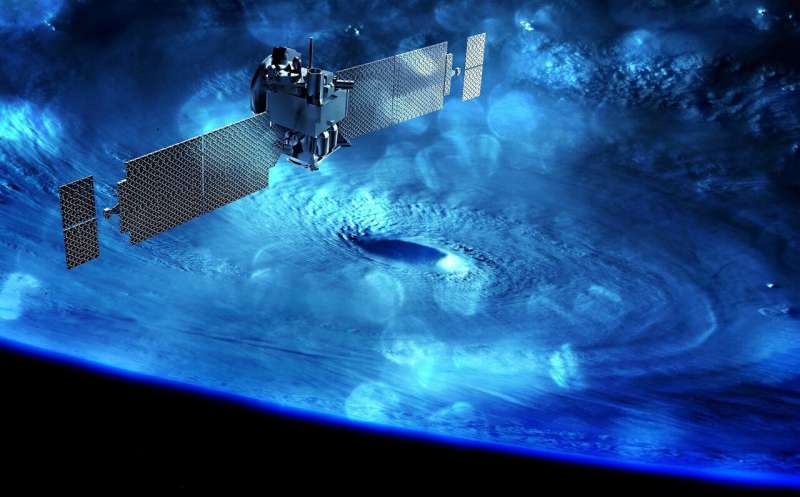
Copernical Team
Meet Dietmar Pilz, new Director of Technology, Engineering and Quality
 Video:
00:06:46
Video:
00:06:46
Dr Dietmar Pilz is ESA’s new Director of Technology, Engineering and Quality (D/TEC), and Head of ESTEC in Noordwijk, the Netherlands.
Dr Pilz has over 20 years of professional experience in the European and international aerospace industry, in various engineering and programme management positions in the defence and security sectors and the space community.
ESA extends AI and cloud computing to space

Despite the rain trickling down the windows, the atmosphere in this room is bright. Twelve teams are gathered in ESA's ESTEC technology centre to explore how we can use the latest developments in AI and advanced computing to make satellites smarter. To make them more reactive, agile and independent.
How space will help football fans to celebrate sport

Millions of supporters avidly follow football clubs across Europe, from Manchester United to Bayern Munich. Now ESA is partnering with UEFA to use space to help ensure the safety of football fans and the sustainability of the sport – as well as exploring other ways in which space can help promote football.
NASA launches two small satellites to track hurricanes

NASA launched two small satellites designed to track tropical cyclones hour by hour from a base in New Zealand on Monday, in a project that could improve weather predictions on devastating storms.
The new storm trackers, sent into orbit on a rocket built by US company Rocket Lab, can fly over hurricanes (or typhoons in the Pacific) every hour, compared to every six hours with current satellites.
Researchers will be able to see storms evolve on an hourly basis, said NASA scientist Will McCarty at a press conference for the first launch of the TROPICS mission.
"We still need the large satellites," he added. "What we get from this is the ability to add more information to the flagship satellites that we already have."
A second Rocket Lab-built vessel is due to launch in about two weeks carrying two more satellites to complete a small constellation of four storm-tracking satellites.
The information gathered on rainfall, temperature and humidity could help scientists determine where a hurricane will make landfall and how intense it will be, helping people living in coastal areas be better prepared for possible evacuations.
Alexandrite laser crystals from Europe for space applications
 Alexandrite laser crystals are well suited for use in earth observation satellites. They are robust and enable laser systems with a tunable output wavelength. In the European Horizon 2020 project GALACTIC, the partners Laser Zentrum Hannover e.V. (LZH), Optomaterials S.r.l. (Italy) and Altechna (Lithuania) have now succeeded in establishing a solely European supply chain for alexandrite laser cr
Alexandrite laser crystals are well suited for use in earth observation satellites. They are robust and enable laser systems with a tunable output wavelength. In the European Horizon 2020 project GALACTIC, the partners Laser Zentrum Hannover e.V. (LZH), Optomaterials S.r.l. (Italy) and Altechna (Lithuania) have now succeeded in establishing a solely European supply chain for alexandrite laser cr Satellite Data, Applications Flowing Through SERVIR to Southeast Asia
 More than 50 million people in Vietnam, Cambodia, Thailand, Laos, and Myanmar draw water for drinking and agriculture from the Mekong River. With customized tools that use NASA observations and data, the people who manage that water supply have been improving their decision-making. It is a prime example of the work NASA and the U.S. Agency for International Development (USAID) have been doing to
More than 50 million people in Vietnam, Cambodia, Thailand, Laos, and Myanmar draw water for drinking and agriculture from the Mekong River. With customized tools that use NASA observations and data, the people who manage that water supply have been improving their decision-making. It is a prime example of the work NASA and the U.S. Agency for International Development (USAID) have been doing to Tianzhou-5 cargo craft separates from China's space station
 The China Manned Space Agency announced on Friday that the Tianzhou-5 cargo spacecraft successfully separated from China's space station at 3:26 p.m. Beijing Time. The spacecraft, which had been supporting the Shenzhou-15 crewed mission, is now in independent flight mode.
Tianzhou-5 was launched on November 12, 2022, from the Wenchang Spacecraft Launch Site in Hainan, a southern province o
The China Manned Space Agency announced on Friday that the Tianzhou-5 cargo spacecraft successfully separated from China's space station at 3:26 p.m. Beijing Time. The spacecraft, which had been supporting the Shenzhou-15 crewed mission, is now in independent flight mode.
Tianzhou-5 was launched on November 12, 2022, from the Wenchang Spacecraft Launch Site in Hainan, a southern province o Lockheed Martin Space announces changes designed to enhance speed and effectiveness
 The Space business area within Lockheed Martin (NYSE: LMT) has announced upcoming changes in order to promote greater effectiveness in delivering on customer missions, support growth and innovation, and create stronger collaboration with customers, suppliers and partners. The realignment follows the recent establishment of Lockheed Martin Space's Ignite organization, an innovation hub for rapid
The Space business area within Lockheed Martin (NYSE: LMT) has announced upcoming changes in order to promote greater effectiveness in delivering on customer missions, support growth and innovation, and create stronger collaboration with customers, suppliers and partners. The realignment follows the recent establishment of Lockheed Martin Space's Ignite organization, an innovation hub for rapid Sidus Space's external flight test returns radiation and structural integrity data for AU Experiment
 Sidus Space, Inc. (NASDAQ:SIDU), a Space and Defense-as-a-Service satellite company focused on mission-critical hardware manufacturing; multi-disciplinary engineering services; satellite design, production, launch planning, mission operations; and in-orbit support has announced the successful completion of a groundbreaking external flight test platform mission.
In November of 2019, twelve
Sidus Space, Inc. (NASDAQ:SIDU), a Space and Defense-as-a-Service satellite company focused on mission-critical hardware manufacturing; multi-disciplinary engineering services; satellite design, production, launch planning, mission operations; and in-orbit support has announced the successful completion of a groundbreaking external flight test platform mission.
In November of 2019, twelve Exciton fission - one photon in, two electrons out
 "When pentacene is excited by light, the electrons in the material rapidly react," explains Prof. Ralph Ernstorfer, a senior author of the study. "It was an open and very disputed question whether a photon excites two electrons directly or initially one electron, which subsequently shares its energy with another electron."
To unravel this mystery the researchers used time- and angle-resolv
"When pentacene is excited by light, the electrons in the material rapidly react," explains Prof. Ralph Ernstorfer, a senior author of the study. "It was an open and very disputed question whether a photon excites two electrons directly or initially one electron, which subsequently shares its energy with another electron."
To unravel this mystery the researchers used time- and angle-resolv 
